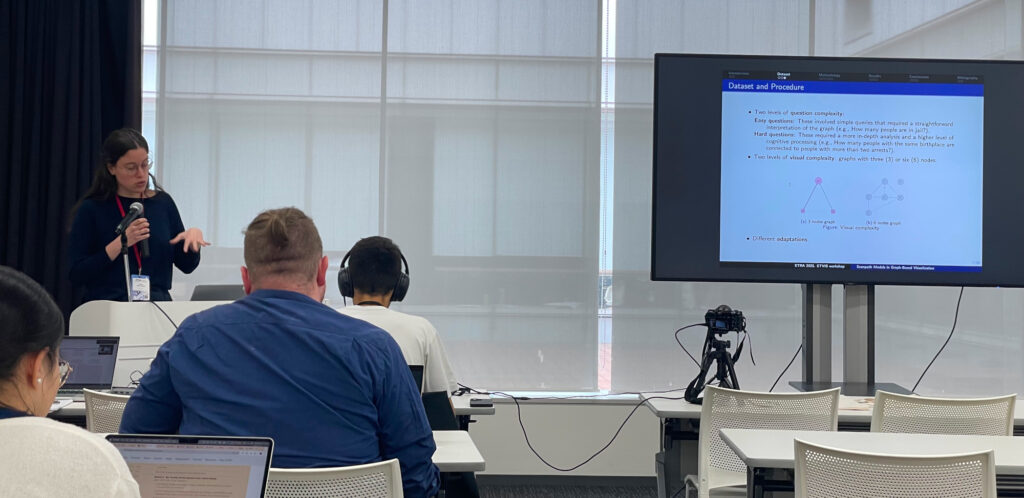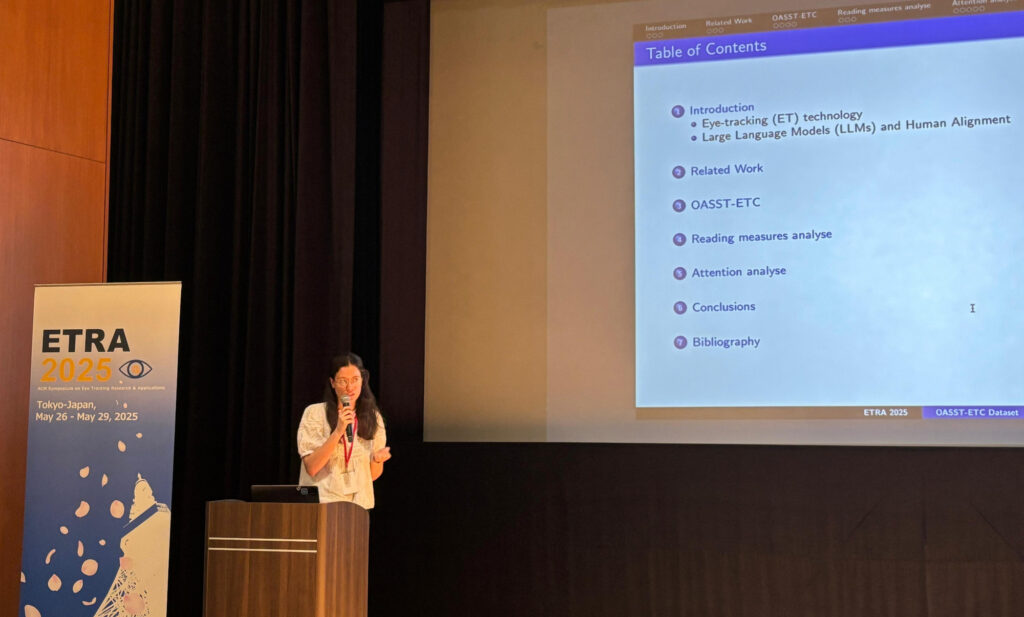The 2025 ACM Symposium on Eye Tracking Research and Applications (ETRA), the premier conference in the field of eye-tracking, was held in Tokyo, Japan, from May 26th to May 29th. The event brought together researchers and practitioners to explore cutting-edge developments and innovative applications shaping the future of eye-tracking technology. It was a great experience, offering the opportunity to meet and connect with experts in the field, as well as to explore the beautiful city of Tokyo.
Ángela López Cardona, from Telefónica Scientific Research, presented “OASST-ETC Dataset: Alignment Signals from Eye-tracking Analysis of LLM Responses” [1], co-authored by her colleagues Dr. Sebastián Idesis, Dr. Miguel Barreda-Ángeles, Dr. Sergi Abadal, and Dr. Ioannis Arapakis. The study involved collecting eye-tracking data in a controlled laboratory setting as participants read responses generated by Large Language Models (LLMs) to specific prompts. The researchers analyzed reading patterns associated with two alternative responses, later used as preference data for model alignment, and compared them with patterns predicted by scanpath models. Additionally, human attention, captured in the reading metrics, was examined and contrasted with the attention mechanisms of various transformer-based LLMs to explore potential correlations between human and model processing of preferred versus non-preferred responses.
She also presented the paper “A Comparative Study of Scanpath Models in Graph-Based Visualization” [2], co-authored by Dr. Sebastian Idesis and Dr. Ioannis Arapakis from Telefonica and also by Parvin Emami, Dr. Saravana Duraisamy, and Prof. Luis A. Leiva from the University of Luxembourg. This study investigates how computational models can predict visual attention in information visualization (InfoVis) systems, addressing the challenges of collecting eye-tracking data. Forty participants completed a digital forensics task while their gaze patterns were recorded and compared to those generated by models like DeepGaze [3], UMSS [4], and Gazeformer [5]. The results reveal how model performance varies with question complexity and graph structure, offering insights to improve predictive modeling and interface design in InfoVis.
These papers are key to SYMBIOTIK as they help to improve the reliability of eye-tracking methodology, enabling more reliable prediction of user visual attention to enhance the adaptation of visualizations, which aligns with the project’s ultimate goal of creating a symbiotic human-AI cooperation.



References
- Angela Lopez-Cardona, Sebastian Idesis, Miguel Barreda-Ángeles, Sergi Abadal, Ioannis Arapakis. OASST-ETC Dataset: Alignment Signals from Eye-tracking Analysis of LLM Responses. Proceedings of the ACM on Human-Computer Interaction, 9(3), 2025. https://doi.org/10.1145/3725840
- Angela Lopez-Cardona, Parvin Emami, Sebastian Idesis, Saravanakumar Duraisamy, Luis A. Leiva, Ioannis Arapakis. A Comparative Study of Scanpath Models in Graph-Based Visualization. Proceedings of the 2025 Symposium on Eye Tracking Research and Applications (ETRA), 2025. https://doi.org/10.1145/3715669.3725882
- Matthias Kümmerer, Matthias Bethge, and Thomas S. A. Wallis. DeepGaze III: Modeling free-viewing human scanpaths with deep learning. Journal of Vision 22(5), 2022. https://doi.org/10.1167/jov.22.5.7
- Yao Wang, Mihai Bâce, and Andreas Bulling. Scanpath Prediction on Information Visualisations. IEEE Trans. Visual. Comput. Graphics 30(7), 2024. https://doi.org/10.1109/TVCG.2023.3242293
- Sounak Mondal, Zhibo Yang, Seoyoung Ahn, Dimitris Samaras, Gregory Zelinsky, and Minh Hoai. Gazeformer: Scalable, Effective and Fast Prediction of Goal- Directed Human Attention. In 2023 IEEE/CVF Conference on Computer Vision and Pattern Recognition (CVPR), 2023. https://doi.org/10.1109/CVPR52729.2023.00145
